AI Research
Stories of the last Moon men

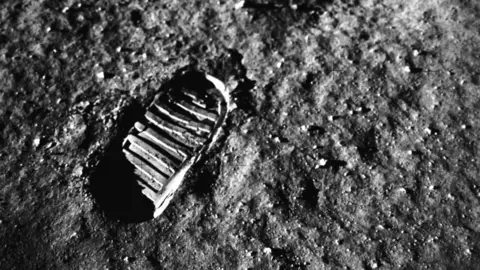 NASA
NASAThey were the pioneers of space exploration – the 24 Nasa astronauts who travelled to the Moon in the Apollo missions of the 1960s and 1970s.
The death of Apollo 13 commander Jim Lovell, who guided the stricken mission safely back to Earth in 1970, means there are now just five people remaining who have escaped the relative safety of Earth orbit and ventured deeper into space.
More than 50 years since a human last set foot on the Moon, the race to put people back on the lunar surface is heating up once again.
Nasa hopes its Artemis programme will lead to astronauts living on the Moon this decade. China is also aiming to have people on the lunar surface by 2030, having landed a probe on the far side of the Moon in June 2024.
A number of private companies have tried to send scientific craft to the Moon, although the mishaps have outnumbered the successes.
Nasa had intended to launch Artemis 2, its first crewed lunar expedition since Apollo 17 in 1972, last year but that date has slipped into 2026, as the space agency says it needs more time to prepare.
Meanwhile, companies such as SpaceX and Boeing continue to develop their own technology, although not without their setbacks.
The issues with Boeing’s Starliner which left two astronauts stranded on the International Space Station were embarrassing for the aerospace giant, while the “rapid unscheduled disassemblies” of SpaceX’s Starship have become a customary sight to space watchers.
These delays highlight the sad fact that the number of remaining Apollo astronauts is dwindling.
 NASA
NASAAlong with Frank Borman and Bill Anders, Jim Lovell made history when the three undertook the first lunar mission on Apollo 8, testing the Command/Service Module and its life support systems in preparation for the later Apollo 11 landing.
Their craft actually made 10 orbits of the Moon before returning home. Lovell was later supposed be the fifth human to walk on the lunar surface as commander of Apollo 13 – but of course, that never happened.
Instead the story of his brush with death was immortalised in the film Apollo 13, in which he was played by Tom Hanks.
Following his retirement from Nasa in 1973, Lovell worked in the telecoms industry. Marilyn, his wife of more than 60 years, who became a focus for the media during the infamous incident, died in August 2023.
But what of the remaining five Moon men?
Who are they, and what are their stories?
Buzz Aldrin (Apollo 11)
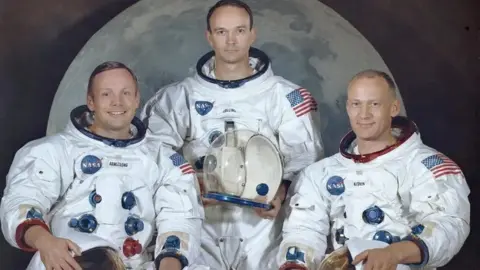 NASA
NASAOn 21 July 1969, former fighter pilot Edwin “Buzz” Aldrin left his lunar landing craft and became the second person to step on the surface of the Moon. Almost 20 minutes beforehand, his commander, Neil Armstrong, had been the first.
Aldrin’s first words were: “Beautiful view”.
“Isn’t that something?” asked Armstrong.”Magnificent sight out here.”
“Magnificent desolation,” replied Aldrin.
The fact that he was second never sat comfortably with him. His crewmate Michael Collins said Aldrin “resented not being first on the Moon more than he appreciated being second”.
But Aldrin was still proud of his achievement; many years later, when confronted by a man claiming Apollo 11 was an elaborate lie, the 72-year-old Aldrin punched him on the jaw.
And following Neil Armstrong’s death in 2012, Aldrin said: “I know I am joined by many millions of others from around the world in mourning the passing of a true American hero and the best pilot I ever knew.”
Despite struggles in later life, he never lost his thirst for adventure and joined expeditions to both the North and South Poles, the latter at the age of 86.
Allow X content?
While embracing his celebrity, he has remained an advocate for the space programme, especially the need to explore Mars.
“I don’t think we should just go there and come back – we did that with Apollo,” he says.
And his name has become known to new generations as the inspiration for Buzz Lightyear from the Toy Story series of films. In January 2023, at the age of 93, he married for a fourth time..
Charles Duke (Apollo 16)
There are only four people still alive who have walked on the Moon – Charlie Duke is one of them. He did it aged 36, making him the youngest person to set foot on the lunar surface.
In a later BBC interview, he spoke of a “spectacular terrain”.
“The beauty of it… the sharp contrast between the blackness of space and the horizon of the Moon… I’ll never forget it. It was so dramatic.”
But he had already played another significant role in Nasa’s exploration of the Moon. After Apollo 11 touched down in 1969, it was Duke – in mission control as the Capsule Communicator, or Capcom – who was waiting nervously on the other end of the line when Neil Armstrong said: “Houston, Tranquility Base here. The Eagle has landed.”
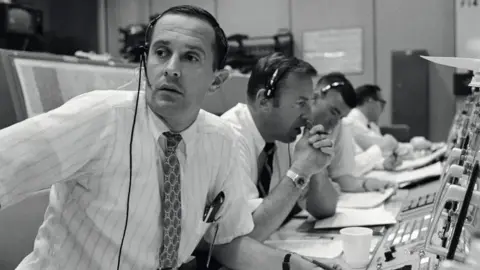 NASA
NASAIn his distinctive southern drawl, Duke replied: “Roger, Tranquility. We copy you on the ground, you’ve got a bunch of guys about to turn blue, we’re breathing again.”
“I really meant it, I was holding my breath the last minute or so,” he later told the BBC.
In 2022, Duke told the BBC he was excited about Nasa’s Artemis mission – but warned that it wouldn’t be easy for the new generation of astronauts.
“They’ve picked near the South Pole for the landing, because if there’s any ice on the Moon, it would be down in that region. So that’s gonna be difficult – because it’s really rough down there. But we’ll pull it off.”
Charlie Duke now lives outside San Antonio, Texas, with Dorothy, to whom he has been married for 60 years.
Fred Haise
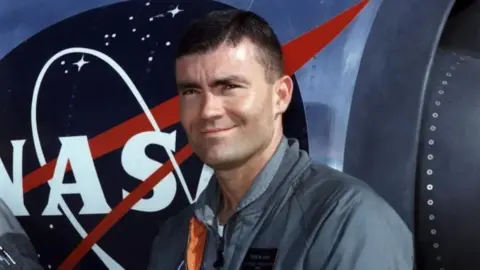 NASA
NASAFred Haise was part of the crew of Apollo 13 that narrowly avoided disaster in 1970 after an on-board explosion caused the mission to be aborted when the craft was more than 200,000 miles (321,000km) from Earth.
The whole world watched nervously as Nasa attempted to return the damaged spacecraft and its crew safely. Once back, Haise and his crewmates James Lovell and Jack Swigert became celebrities, to their apparent surprise.
“I feel like maybe I missed something while I was up there,” he told talk show host Johnny Carson when the crew appeared on The Tonight Show.
Haise never made it to the Moon. Although scheduled to be commander of Apollo 19, that mission was cancelled because of budget cuts, as were all other flights after Apollo 17.
He later served as a test pilot on the prototype space shuttle, Enterprise.
Like many of his fellow Apollo alumni, after leaving Nasa, Haise continued to work in the aerospace industry until his retirement.
Harrison Schmitt (Apollo 17)
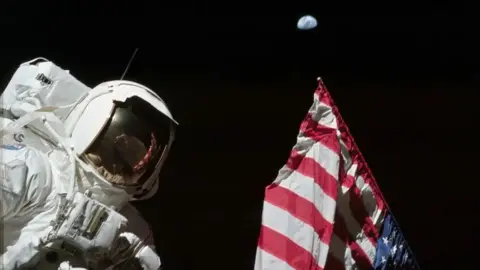 NASA
NASAUnlike most other astronauts of the time, Schmitt had not served as a pilot in the US forces.
A geologist and academic, he initially instructed Nasa astronauts on what to look for during their geological lunar field trips before becoming a scientist-astronaut himself in 1965.
Schmitt was part of the last crewed mission to the Moon, Apollo 17, and along with commander Eugene Cernan, one of the last two men to set foot on the lunar surface, in December 1972.
After leaving Nasa in 1975, he was elected to the US Senate from his home state of New Mexico, but only served one term. Since then he has worked as a consultant in various industries as well as continuing in academia.
He is also known for speaking out against the scientific consensus on climate change.
David Scott (Apollo 15)
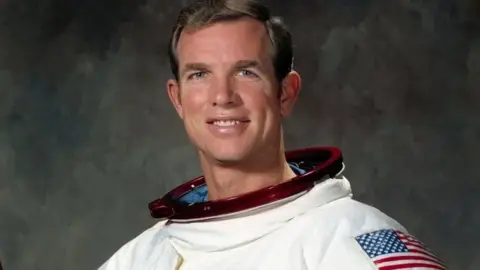 NASA
NASADavid Scott, the commander of Apollo 15, is one of just four men alive who have walked on the Moon – but he was also one of the first to drive on it too.
In 1971, Scott and crewmate James Irwin tested out the Lunar Roving Vehicle (LRV), “Man’s First Wheels on the Moon” as it was called. Travelling at speeds up to 8 mph (12 km/h) the LRV allowed astronauts to travel large distances from the lunar lander much quicker than they could walk.
“On a first mission you never know whether it’s going to work,” he later recalled. “The greatest thrill was to get it out, turn it on, and it actually worked.”
After returning from the Moon, Scott worked in various management roles within Nasa, before joining the private sector.
He has also acted as consultant on several film and television projects, including Apollo 13 and the HBO miniseries From The Earth To The Moon.
What will the next generation of lunar adventurers accomplish?
AI Research
(Policy Address 2025) HK earmarks HK$3B for AI research and talent recruitment – The Standard (HK)
AI Research
[2506.08171] Worst-Case Symbolic Constraints Analysis and Generalisation with Large Language Models

View a PDF of the paper titled Worst-Case Symbolic Constraints Analysis and Generalisation with Large Language Models, by Daniel Koh and 4 other authors
Abstract:Large language models (LLMs) have demonstrated strong performance on coding tasks such as generation, completion and repair, but their ability to handle complex symbolic reasoning over code still remains underexplored. We introduce the task of worst-case symbolic constraints analysis, which requires inferring the symbolic constraints that characterise worst-case program executions; these constraints can be solved to obtain inputs that expose performance bottlenecks or denial-of-service vulnerabilities in software systems. We show that even state-of-the-art LLMs (e.g., GPT-5) struggle when applied directly on this task. To address this challenge, we propose WARP, an innovative neurosymbolic approach that computes worst-case constraints on smaller concrete input sizes using existing program analysis tools, and then leverages LLMs to generalise these constraints to larger input sizes. Concretely, WARP comprises: (1) an incremental strategy for LLM-based worst-case reasoning, (2) a solver-aligned neurosymbolic framework that integrates reinforcement learning with SMT (Satisfiability Modulo Theories) solving, and (3) a curated dataset of symbolic constraints. Experimental results show that WARP consistently improves performance on worst-case constraint reasoning. Leveraging the curated constraint dataset, we use reinforcement learning to fine-tune a model, WARP-1.0-3B, which significantly outperforms size-matched and even larger baselines. These results demonstrate that incremental constraint reasoning enhances LLMs’ ability to handle symbolic reasoning and highlight the potential for deeper integration between neural learning and formal methods in rigorous program analysis.
Submission history
From: Daniel Koh [view email]
[v1]
Mon, 9 Jun 2025 19:33:30 UTC (1,462 KB)
[v2]
Tue, 16 Sep 2025 10:35:33 UTC (1,871 KB)
AI Research
‘AI Learning Day’ spotlights smart campus and ecosystem co-creation

When artificial intelligence (AI) can help you retrieve literature, support your research, and even act as a “super assistant”, university education is undergoing a profound transformation.
On 9 September, XJTLU’s Centre for Knowledge and Information (CKI) hosted its third AI Learning Day, themed “AI-Empowered, Ecosystem-Co-created”. The event showcased the latest milestones of the University’s “Education + AI” strategy and offered in-depth discussions on the role of AI in higher education.
In her opening remarks, Professor Qiuling Chao, Vice President of XJTLU, said: “AI offers us an opportunity to rethink education, helping us create a learning environment that is fairer, more efficient and more personalised. I hope today’s event will inspire everyone to explore how AI technologies can be applied in your own practice.”
Professor Qiuling Chao
In his keynote speech, Professor Youmin Xi, Executive President of XJTLU, elaborated on the University’s vision for future universities. He stressed that future universities would evolve into human-AI symbiotic ecosystems, where learning would be centred on project-based co-creation and human-AI collaboration. The role of educators, he noted, would shift from transmitters of knowledge to mentors for both learning and life.

Professor Youmin Xi
At the event, Professor Xi’s digital twin, created by the XJTLU Virtual Engineering Centre in collaboration with the team led by Qilei Sun from the Academy of Artificial Intelligence, delivered Teachers’ Day greetings to all staff.
(Teachers’ Day message from President Xi’s digital twin)
“Education + AI” in diverse scenarios
This event also highlighted four case studies from different areas of the University. Dr Ling Xia from the Global Cultures and Languages Hub suggested that in the AI era, curricula should undergo de-skilling (assigning repetitive tasks to AI), re-skilling, and up-skilling, thereby enabling students to focus on in-depth learning in critical thinking and research methodologies.
Dr Xiangyun Lu from International Business School Suzhou (IBSS) demonstrated how AI teaching assistants and the University’s Junmou AI platform can offer students a customised and highly interactive learning experience, particularly for those facing challenges such as information overload and language barriers.
Dr Juan Li from the School of Science shared the concept of the “AI amplifier” for research. She explained that the “double amplifier” effect works in two stages: AI first amplifies students’ efficiency by automating tasks like literature searches and coding. These empowered students then become the second amplifier, freeing mentors from routine work so they can focus on high-level strategy. This human-AI partnership allows a small research team to achieve the output of a much larger one.
Jing Wang, Deputy Director of the XJTLU Learning Mall, showed how AI agents are already being used to support scheduling, meeting bookings, news updates and other administrative and learning tasks. She also announced that from this semester, all students would have access to the XIPU AI Agent platform.

Students and teachers are having a discussion at one of the booths
AI education system co-created by staff and students
The event’s AI interactive zone also drew significant attention from students and staff. From the Junmou AI platform to the E
-Support chatbot, and from AI-assisted creative design to 3D printing, 10 exhibition booths demonstrated the integration of AI across campus life.
These innovative applications sparked lively discussions and thoughtful reflections among participants. In an interview, Thomas Durham from IBSS noted that, although he had rarely used AI before, the event was highly inspiring and motivated him to explore its use in both professional and personal life. He also shared his perspective on AI’s role in learning, stating: “My expectation for the future of AI in education is that it should help students think critically. My worry is that AI’s convenience and efficiency might make students’ understanding too superficial, since AI does much of the hard work for them. Hopefully, critical thinking will still be preserved.”
Year One student Zifei Xu was particularly inspired by the interdisciplinary collaboration on display at the event, remarking that it offered her a glimpse of a more holistic and future-focused education.
Dr Xin Bi, XJTLU’s Chief Officer of Data and Director of the CKI, noted that, supported by robust digital infrastructure such as the Junmou AI platform, more than 26,000 students and 2,400 staff are already using the University’s AI platforms. XJTLU’s digital transformation is advancing from informatisation and digitisation towards intelligentisation, with AI expected to empower teaching, research and administration, and to help staff and students leap from knowledge to wisdom.

Dr Xin Bi
“Looking ahead, we will continue to advance the deep integration of AI in education, research, administration and services, building a data-driven intelligent operations centre and fostering a sustainable AI learning ecosystem,” said Dr Xin Bi.
By Qinru Liu
Edited by Patricia Pieterse
Translated by Xiangyin Han
-

 Business3 weeks ago
Business3 weeks agoThe Guardian view on Trump and the Fed: independence is no substitute for accountability | Editorial
-
Tools & Platforms1 month ago
Building Trust in Military AI Starts with Opening the Black Box – War on the Rocks
-

 Ethics & Policy2 months ago
Ethics & Policy2 months agoSDAIA Supports Saudi Arabia’s Leadership in Shaping Global AI Ethics, Policy, and Research – وكالة الأنباء السعودية
-

 Events & Conferences4 months ago
Events & Conferences4 months agoJourney to 1000 models: Scaling Instagram’s recommendation system
-

 Jobs & Careers3 months ago
Jobs & Careers3 months agoMumbai-based Perplexity Alternative Has 60k+ Users Without Funding
-

 Podcasts & Talks2 months ago
Podcasts & Talks2 months agoHappy 4th of July! 🎆 Made with Veo 3 in Gemini
-

 Education2 months ago
Education2 months agoMacron says UK and France have duty to tackle illegal migration ‘with humanity, solidarity and firmness’ – UK politics live | Politics
-

 Education3 months ago
Education3 months agoVEX Robotics launches AI-powered classroom robotics system
-

 Podcasts & Talks2 months ago
Podcasts & Talks2 months agoOpenAI 🤝 @teamganassi
-

 Funding & Business3 months ago
Funding & Business3 months agoKayak and Expedia race to build AI travel agents that turn social posts into itineraries


